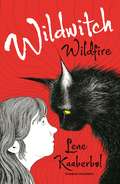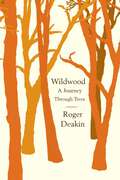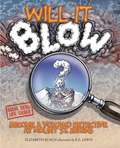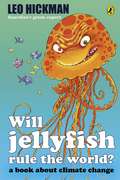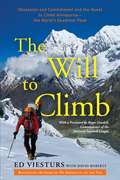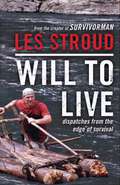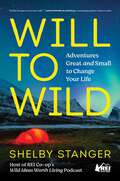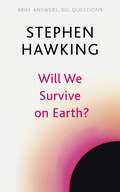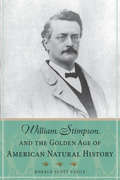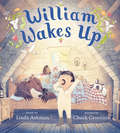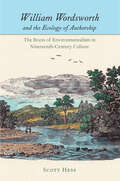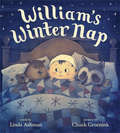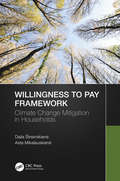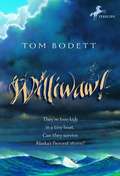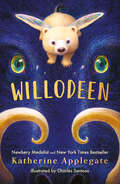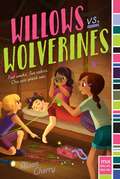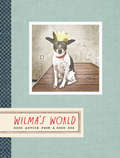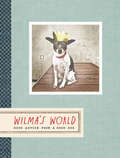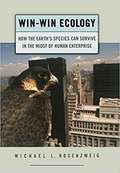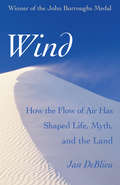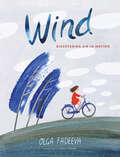- Table View
- List View
Wildwitch: Volume One
by Rohan Eason Lene Kaaberbol Charlotte BarslundFrom Lene Kaaberbøl, known as the Danish J.K. Rowling: Book one in the Wildwitch series, an acclaimed new children's fantasy series about a young girl who can communicate with and control the natural world.Twelve-year-old Clara is an ordinary girl, so small and shy that her mum calls her Little Mouse. Then, one day, she meets a cat. A huge, strange, black cat, with glowing yellow eyes. And so begins her new life as a wildwitch.Suddenly, Clara is plunged into a world of mystery and magic. With her Aunt Isa to guide her, she finds she can talk to animals and walk the mysterious Wildways. But then she is captured by the dreaded Chimera...From the Trade Paperback edition.
Wildwood: A Journey Through Trees
by Roger DeakinHere, published for the first time in the United States, is the last book by Roger Deakin, famed British nature writer and icon of the environmentalist movement. In Deakin's glorious meditation on wood, the "fifth element" -- as it exists in nature, in our culture, and in our souls -- the reader accompanies Deakin through the woods of Britain, Europe, Kazakhstan, and Australia in search of what lies behind man's profound and enduring connection with trees. Deakin lives in forest shacks, goes "coppicing" in Suffolk, swims beneath the walnut trees of the Haut-Languedoc, and hunts bushplums with Aboriginal women in the outback. Along the way, he ferrets out the mysteries of woods, detailing the life stories of the timber beams composing his Elizabethan house and searching for the origin of the apple. As the world's forests are whittled away, Deakin's sparkling prose evokes woodlands anarchic with life, rendering each tree as an individual, living being. At once a traveler's tale and a splendid work of natural history, Wildwood reveals, amid the world's marvelous diversity, that which is universal in human experience.
Will China Save The Planet?
by Barbara FinamoreNow that Trump has turned the United States into a global climate outcast, will China take the lead in saving our planet from environmental catastrophe? Many signs point to yes. China, the world's largest carbon emitter, is leading a global clean energy revolution, phasing out coal consumption and leading the development of a global system of green finance. <p><p> But as leading China environmental expert Barbara Finamore explains, it is anything but easy. The fundamental economic and political challenges that China faces in addressing its domestic environmental crisis threaten to derail its low-carbon energy transition. Yet there is reason for hope. China's leaders understand that transforming the world's second largest economy from one dependent on highly polluting heavy industry to one focused on clean energy, services and innovation is essential, not only to the future of the planet, but to China's own prosperity.
Will It Blow?: Become a Volcano Detective at Mount St. Helens
by Elizabeth RuschThis book helps the reader to become a volcano detective who can decipher volcanic clues,with real life cases from Mount St. Helens.
Will Jellyfish Rule the World?: A Book About Climate Change
by Leo HickmanFrom what makes Earth so special, to how scientists know for sure our climate is changing, why it's a big deal for everyone and what we can all do right now to make a difference, green expert Leo Hickman is ready to answer all your questions.Will Jellyfish Rule the World? breaks down the causes and effects of climate change in a fresh, fun and easy-to-follow format. Packed with practical everyday things we can all do right now to make a difference, Will Jellyfish Rule the World? is a comprehensive, easy-to-use eco-handbook for budding classroom environmentalists everywhere.
The Will to Climb: Obsession and Commitment and the Quest to Climb Annapurna--the World's Deadliest Peak
by David Roberts Ed ViestursThe bestselling author of No Shortcuts to the Top and K2 chronicles his three attempts to climb the world's tenth-highest and statistically deadliest peak, Annapurna in the Himalaya, while exploring the dramatic and tragic history of others who have made -- or attempted - the ascent, and what these exploits teach us about facing life's greatest challenges. As a high school student in the flatlands of Rockford, Illinois, where the highest objects on the horizon were water towers, Ed Viesturs read and was captivated by the French climber Maurice Herzog's famous and grisly account of the first ascent of Annapurna in 1950. When he began his own campaign to climb the world's 14 highest peaks in the late 1980s, Viesturs looked forward with trepidation to undertaking Annapurna himself. Two failures to summit in 2000 and 2002 made Annapurna his nemesis. His successful 2005 ascent was the triumphant capstone of his climbing quest. In The Will To Climb Viesturs brings the extraordinary challenges of Annapurna to vivid life through edge-of-your-seat accounts of the greatest climbs in the mountain's history, and of his own failed attempts and eventual success. In the process he ponders what Annapurna reveals about some of our most fundamental moral and spiritual questions--questions, he believe, that we need to answer to lead our lives well. "Of all fourteen of the world's highest mountains, which I climbed between 1989 and 2005," writes Viesturs, "the one that came the closest to defeating my best efforts was Annapurna." Although it was the first 8,000-meter peak to be climbed, Annapurna is not as well known as the world's highest mountain, Everest, or second highest, K2. But as Viesturs argues, Annapurna, while not technically the most difficult of the 8,000ers, is the most daunting because it has no route--no ridge or face on any side of the mountain--that is relatively free of what climbers call "objective danger"--the threat of avalanches, above all, but also of collapsing seracs (huge ice blocks), falling rocks, and crevasses. Since its first ascent in 1950, Annapurna has been climbed by more than 130 people, but 53 have died trying. This high fatality rate makes Annapurna the most dangerous of the 8,000-meter peaks. Viesturs and co-author David Roberts chronicle Ed's three attempts to climb Annapurna, as well as the attempts of others, from the two French climbers who made the landmark first ascent of Annapurna on June 3, 1950, through the daring and tragic campaigns of such world-class mountaineers as Reinhold Messner and Anatoli Boukreev. Viesturs's accounts and analyses of these extraordinary adventures serve as a point of departure for his exploration of themes vividly illustrated by Annapurna expeditions, including obsession and commitment, fear and fulfillment, failure and triumph--issues that have been neglected in the otherwise very rich literature of mountaineering, and that can inform the lives and actions of everyone.From the Hardcover edition.
Will to Live: Dispatches from the Edge of Survival
by Les StroudIn a survival situation, a wrong decision could spell the difference between life and death. No one knows this better than Les Stroud, who has survived everywhere from the sun-scorched sands of the Kalahari to the snake-infested jungles of the Amazon. In Will to Live, Les examines many incredible true life survival stories—explaining what happened and why, and offering valuable perspectives on what went right, what went wrong, and what could have been done differently. The tales in Will to Live include:Chris McCandless—the subject of the book and movie Into the Wild.Yossi Ghinsberg—who survived alone in the Amazon for twenty-one days.Douglas Mawson—the Antarctic "superman" who survived three hellish months at the bottom of the planet.Nando Parrado—who was trapped for two months high in the Andes after a plane crash killed his friends and family.Plus . . . stories from Les's own experiences, along with practical sidebars with tips on how to escape quicksand, butcher a moose, cross a snow-covered crevasse, and more.Provocative and entertaining, Will to Live is a compilation of history's most intriguing survival stories from one of the world's foremost experts.
Will to Wild: Adventures Great and Small to Change Your Life
by Shelby StangerEmbrace adventures both big and small and pursue your wild ideas with this motivational guidebook from seasoned adventurer and podcaster Shelby Stanger.Will to Wild is an instruction manual to adventure. Your guide: enthusiastic outdoorswoman Shelby Stanger. Shelby has been teaching folks how to leap into the unknown since she taught her first surf class over twenty years ago. Over the years, she watched many of her students quit their jobs, end dysfunctional relationships, and move across the country for a healthier work-life-balance—all after spending a bit of time in nature. Shelby marveled at the phenomenon. Being outside was changing the lives of her students, her peers, and herself. Shelby was so intrigued, she began to tell their stories, first as a writer and journalist, then as a podcast host for Wild Ideas Worth Living, REI Co-op Studio&’s flagship podcast. With her first book, Will to Wild, Shelby shares all she&’s witnessed and learned in her years covering adventurers. It&’s the book she wishes she&’d had when she&’d first felt the urge to leap from familiar to wild terrain. The one that takes you step-by-step from the first inkling of inspiration for your own wild idea through fear and self-doubt and on to the finish line. In these pages, you will find stories with practical tips and tactics from world-famous rock climbers and ultra-runners, to longtime thru-hikers, surfers, desk jockeys who&’ve figured out how to get off the clock, and even a suburban mom who started teaching women to scale frozen waterfalls in her mid-fifties. Along with Shelby&’s stories, they will show you how to get unstuck, how to pay attention to &“trail signs&” that point you toward your adventure, how to face your fears, and what to do when everything goes haywire (which will likely happen, never fear!). With Shelby&’s characteristic strength and vulnerability, Will to Wild encourages you to break out of your comfort zones, get out into nature, and bring their own wild ideas to life. Whether you&’re already an adventure junkie or someone who&’s never set up a tent, there&’s something inside these pages for you.
Will We Survive on Earth? (Brief Answers, Big Questions)
by Stephen Hawking'Be brave, be curious, be determined, overcome the odds. It can be done'Will we survive on Earth?Should we colonise space?Throughout his extraordinary career, Stephen Hawking expanded our understanding of the universe and unravelled some of its greatest mysteries. In Will We Survive on Earth? the world-famous cosmologist and bestselling author of A Brief History of Time turns his attention to one of the most urgent issues for humankind and explores our options for survival.'Effortlessly instructive, absorbing and witty' GuardianBrief Answers, Big Questions: this stunning paperback series offers electrifying essays from one of the greatest minds of our age, taken from the original text of the No. 1 bestselling Brief Answers to the Big Questions.
William Blake: The very best poems from one of the most important figures of the Romantic Age (The Great Poets)
by William Blake'To see the world in a grain of sand, and to see heaven in a wild flower, hold infinity in the palm of your hands, and eternity in an hour' William BlakeWilliam Blake was a poet and artist. Born in Soho in the eighteenth century, the son of a shopkeeper, he is now acclaimed as a radical left-field artist. Most recently, the Tate held an exhibition of his work: 'Magnificent ... reveal's Blake's vision at its most vivid and strange' GUARDIANBlake's written work was equally vivid. A major poet of the Romantic age, the full range of his poetry includes the joyful and sorrowful, the childlike and complex - and illustrates his original and prophetic vision. Considered mad by contemporaries for his idiosyncratic opinions, he is now revered for the depth of his poetry and art, and the philosophical undercurrents intrinsic to all his creative work.'If the Sun and Moon should ever doubt, they'd immediately go out''The imagination is not a state; it is the human existence itself'
William Blake: The very best poems from one of the most important figures of the Romantic Age (The Great Poets)
by William Blake'To see the world in a grain of sand, and to see heaven in a wild flower, hold infinity in the palm of your hands, and eternity in an hour' William BlakeWilliam Blake was a poet and artist. Born in Soho in the eighteenth century, the son of a shopkeeper, he is now acclaimed as a radical left-field artist. Most recently, the Tate held an exhibition of his work: 'Magnificent ... reveal's Blake's vision at its most vivid and strange' GUARDIANBlake's written work was equally vivid. A major poet of the Romantic age, the full range of his poetry includes the joyful and sorrowful, the childlike and complex - and illustrates his original and prophetic vision. Considered mad by contemporaries for his idiosyncratic opinions, he is now revered for the depth of his poetry and art, and the philosophical undercurrents intrinsic to all his creative work.'If the Sun and Moon should ever doubt, they'd immediately go out''The imagination is not a state; it is the human existence itself'
William Stimpson and the Golden Age of American Natural History
by Ronald Scott VasileWilliam Stimpson was at the forefront of the American natural history community in the latter half of the nineteenth century. Stimpson displayed an early affinity for the sea and natural history, and after completing an apprenticeship with famed naturalist Louis Agassiz, he became one of the first professionally trained naturalists in the United States. In 1852, twenty-year-old Stimpson was appointed naturalist of the United States North Pacific Exploring Expedition, where he collected and classified hundreds of marine animals. Upon his return, he joined renowned naturalist Spencer F. Baird at the Smithsonian Institution to create its department of invertebrate zoology. He also founded and led the irreverent and fun-loving Megatherium Club, which included many notable naturalists. In 1865, Stimpson focused on turning the Chicago Academy of Sciences into one of the largest and most important museums in the country. Tragically, the museum was destroyed in the Great Chicago Fire of 1871, and Stimpson died of tuberculosis soon after, before he could restore his scientific legacy. This first-ever biography of William Stimpson situates his work in the context of his time. As one of few to collaborate with both Agassiz and Baird, Stimpson's life provides insight into the men who shaped a generation of naturalists—the last before intense specialization caused naturalists to give way to biologists. Historians of science and general readers interested in biographies, science, and history will enjoy this compelling biography.
William Wakes Up (William)
by Linda AshmanWilliam and his animal friends have had the whole winter to nap. Now it's time for them to wake up and welcome a very special guest. There's lots to do to get ready, from scrubbing the floors to decorating the house to baking a tasty treat. But it's so hard to leave a cozy bed. . . . Will everyone get up in time to do their part?This book's gentle rhymes and humorous illustrations full of signs of spring will make it a little easier to wait for the first warm days of the season.
William Wordsworth and the Ecology of Authorship: The Roots of Environmentalism in Nineteenth-Century Culture (Under the Sign of Nature)
by Scott HessIn William Wordsworth and the Ecology of Authorship, Scott Hess explores Wordsworth’s defining role in establishing what he designates as "the ecology of authorship": a primarily middle-class, nineteenth-century conception of nature associated with aesthetics, high culture, individualism, and nation. Instead of viewing Wordsworth as an early ecologist, Hess places him within a context that is largely cultural and aesthetic. The supposedly universal Wordsworthian vision of nature, Hess argues, was in this sense specifically male, middle-class, professional, and culturally elite—factors that continue to shape the environmental movement today.
William's Winter Nap: An Ebook With Audio
by Linda AshmanJust when William is ready to fall asleep in his cozy cabin, there is a tap on his window. A chilly chipmunk asks to stay, and Will scooches over in bed. "There's room for two--I'm sure we'll fit." The chipmunk is just the first in a parade of mammals, each bigger than the last, until the bed is full. Then a note is slipped beneath the door: "Do you have room for just one more?" William tugs the door to see who's there . . . only to find a great big BEAR! Is there enough space to spare? Will the other animals be willing to share?Kids will delight at each new guest's arrival and enjoy counting along as the animals keep scooching over to fit in William's bed. Linda Ashman's clever rhymes set up each page turn with suspense and humor, and the expressions on Chuck Groenink's characters are perfect. This is must reading for the dark time of year when everyone wants to hibernate!
William's Winter Nap: An eBook with Audio
by Linda AshmanJust when William is ready to fall asleep in his cozy cabin, there is a tap on his window. A chilly chipmunk asks to stay, and Will scooches over in bed. "There's room for two--I'm sure we'll fit." The chipmunk is just the first in a parade of mammals, each bigger than the last, until the bed is full. Then a note is slipped beneath the door: "Do you have room for just one more?" William tugs the door to see who's there . . . only to find a great big BEAR! Is there enough space to spare? Will the other animals be willing to share?Kids will delight at each new guest's arrival and enjoy counting along as the animals keep scooching over to fit in William's bed. Linda Ashman's clever rhymes set up each page turn with suspense and humor, and the expressions on Chuck Groenink's characters are perfect. This is must reading for the dark time of year when everyone wants to hibernate!
Willingness to Pay Framework: Climate Change Mitigation in Households
by Dalia Štreimikienė Asta MikalauskienėThis book aims to develop a framework for the assessment of population ‘preferences in climate change mitigation policies by applying a Willingness to Pay (WTP) approach and presents the results from several case studies in Lithuania on renewable energy generation and renovation in different households. These analyses of climate change mitigation policies and measures, based on the assessment of their effectiveness, provide recommendations for developing innovative measures in other countries. Since public preferences are variable, climate change mitigation policies can change these preferences and allow to form new ones. Features: Analyses social benefits of climate change mitigation measures and their integration methods based on assessment of public preferences. Presents several practical case studies on energy needs where the Willingness to Pay framework was applied. Discusses climate change mitigation barriers in energy sector and the effectiveness of climate change mitigation policies to overcome them. Provides a novel approach for climate change mitigation policies development in households. Includes useful information for evaluating and planning policies related to renewable energy investment. This book is a useful reference for those in the academic, research, and business communities, policy makers, graduate students, and professionals involved with climate change mitigation projects.
Williwaw!
by Tom BodettFrom humorist, storyteller, author, and the voice of Motel 6 commercials, here is an exciting middle-grade adventure novel set in rural Alaska. <p><p> Ivan and September Crane, ages 12 and 13, are left alone for a couple of weeks while their fisherman Dad is away at sea. In typical adolescent fashion, they quickly proceed to ignore his only two instructions--don't run down the batteries on the portable short-wave radio, their only means of communication, and don't cross the bay to town. <p> Through a series of bad decisions they find themselves crossing Bag Bay in their skiff when they are suddenly overtaken by a sudden and fierce autumn storm known as a williwaw. Ivan and September must use every ounce of strength, courage, and ingenuity they posses to keep themselves afloat until help comes. <p> Williwaw contains rich descriptions of Alaskan geography and wildlife. Its likable characters and taut suspense will keep readers riveted until the last page.
Willodeen
by Katherine ApplegateThe earth is old and we are not, and that is all you must remember . . .Eleven-year-old Willodeen adores creatures of all kinds, but her favourites are the most unlovable beasts in the land: strange beasts known as 'screechers'. The villagers of Perchance call them pests, even monsters, but Willodeen believes the animals serve a vital role in the complicated web of nature.Lately, though, nature has seemed angry indeed. Perchance has been cursed with fires and mudslides, droughts and fevers, and even the annual migration of hummingbears, a source of local pride and income, has dwindled. For as long as anyone can remember, the tiny animals have overwintered in shimmering bubble nests perched atop blue willow trees, drawing tourists from far and wide. This year, however, not a single hummingbear has returned to Perchance, and no one knows why.When a handmade birthday gift brings unexpected magic to Willodeen and her new friend, Connor, she's determined to speak up for the animals she loves, and perhaps even uncover the answer to the mystery of the missing hummingbears.A timely and timeless tale about our fragile earth, and one girl's fierce determination to make a difference.
Willows vs. Wolverines
by Alison CherryIt’s an all-out boys vs. girls prank war in this hilarious summer camp novel from the author of The Classy Crooks Club!Izzy Cervantes and her best friend, Mackenzie, have spent summers together at Camp Sweetwater since they were eight. So when their parents decide to ship them off to Camp Foxtail instead, the girls find themselves completely out of their element—and worse yet, in different cabins! Izzy feels like an outsider in Willow Lodge. But when she hears about the time-honored prank war between the Willows and the Wolverines, the rival boy cabin, she sees a chance to make her mark. Convinced the girls will never accept her as one of them unless she has roots at Camp Foxtail, she boasts that her older brother is the most respected prankster in the camp’s history and would be happy to help them win the war. In reality, Izzy doesn’t even have an older brother, but the Willows embrace her as their new secret weapon, and Mackenzie agrees to help her hatch a series of epic stunts. As the hijinks escalate, so does Izzy’s popularity. But she becomes so focused on impressing her new friends that she starts neglecting Mackenzie, putting her friendship and her secret prank-master identity in serious jeopardy. Can Izzy keep the truth under wraps and win her best friend back, or will she end up on the wrong side of her allies as well as her enemies?
Wilma's World: Good Advice from a Good Dog
by Rae DunnWelcome to Wilma's World, where life is full of joy and adventure lies around every corner. This charming book of photographs celebrates the wise insights of a special dog whose musings remind us to slow down and see the beauty in simple things. Wilma's handmade style and playful personality will inspire adventurous spirits everywhere.
Wilma's World: Good Advice from a Good Dog
by Rae DunnWelcome to Wilma's World, where life is full of joy and adventure lies around every corner. This charming book of photographs celebrates the wise insights of a special dog whose musings remind us to slow down and see the beauty in simple things. Wilma's handmade style and playful personality will inspire adventurous spirits everywhere.
Win-Win Ecology: How the Earth's Species Can Survive In the Midst of Human Enterprise
by Michael L. RosenzweigAs humanity presses down inexorably on the natural world, people debate the extent to which we can save the Earth's millions of different species without sacrificing human economic welfare. But is this argument wise? Must the human and natural worlds be adversaries? In this book, ecologist Michael Rosenzweig finds that ecological science actually rejects such polarization. Instead it suggests that, to be successful, conservation must discover how we can blend a rich natural world into the world of economic activity. This revolutionary, common ground between development and conservation is called reconciliation ecology: creating and maintaining species-friendly habitats in the very places where people live, work, or play. The book offers many inspiring examples of the good results already achieved. The Nature Conservancy, for instance, has a cooperative agreement with the Department of Defense, with more than 200 conservation projects taking place on more than 170 bases in 41 states. In places such as Elgin Air Force Base, the human uses-testing munitions, profitable timbering and recreation--continue, but populations of several threatened species on the base, such as the long-leaf pine and the red-cockaded woodpecker, have been greatly improved. The Safe Harbor strategy of the Fish & Wildlife Service encourages private landowners to improve their property for endangered species, thus overcoming the unintended negative aspects of the Endangered Species Act. And Golden Gate Park, which began as a system of sand dunes, has become, through human effort, a world of ponds and shrubs, waterfowl and trees. Rosenzweig shows that reconciliation ecology is the missing tool of conservation, the practical, scientifically based approach that, when added to the rest, will solve the problem of preserving Earth's species.
Wind
by Jan DeblieuThe wind has sculpted Earth from the beginning of time, but it has also shaped humans--our histories, religions and cultures, the way we build our dwellings, and how we think and feel. In this poetic, acclaimed work, Jan DeBlieu takes the tempests of her home, the North Carolina Outer Banks, as a starting point for considering how the world's breezes and gales have made us who we are. She travels widely, seeking out the scientists, sailors and sages who, like her, are haunted by the movement of air.
Wind
by Olga FadeevaA browsable, appealing introduction to an important weather phenomenon.If your hair has ever blown back on a breezy day, you&’ve noticed the wind at work. But what causes the wind? Are there different types of wind? How do we measure and name them? How does the wind shape our ecosystems, plants, and animals? What about people: how have human beings used the wind in the past and the present? Can you really sail into the wind, and would a tailwind help or hurt your plane&’s takeoff? Up, up beyond the clouds, does the wind affect other planets, too? Created with help from a meteorologist, this beautiful book is a fascinating exploration of the wind&’s role in world history and earth science. Playful prose and colorful illustrations invite children to bring their questions along as they learn more about this powerful—but sometimes overlooked—natural element.
